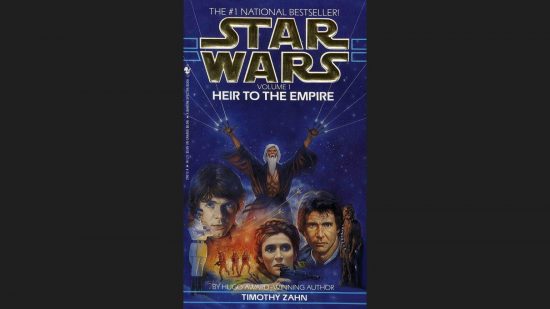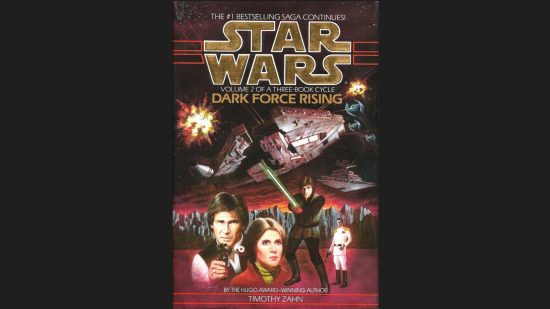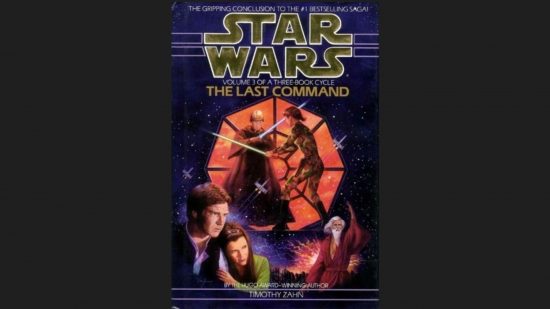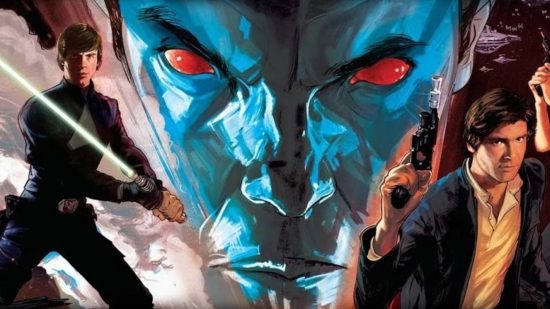Our Verdict
Filled with interesting new characters and concepts, these novels are a fantastic continuation of the Star Wars saga after Return of the Jedi. A few silly bits aside, it's an excellent trilogy.
The Thrawn Trilogy was the cornerstone of the old Star Wars Legends continuity, the pre-Disney novels, comics, and videogames of the Star Wars expanded universe. Beginning five years after Return of the Jedi, Timothy Zahn’s three novels follow Luke, Leia, Han, and Lando as the fledgling New Republic faces the last of the Empire’s Grand Admirals, a master strategist named Thrawn, and his ally, the mad Jedi Joruus C’baoth.
Regarded as some of the best Star Wars novels of both the old and new expanded universes, this trilogy introduced many new fan-favorite characters (including Mara Jade and, of course, Grand Admiral Thrawn himself), gave us our first look at the New Republic, and laid plot threads that the rest of the Star Wars expanded universe would follow for years. So popular was Thrawn that he has since been resurrected for Star Wars Rebels, two new trilogies of novels by Timothy Zahn, and has even made the transition into live action in the latest Disney Plus Star Wars series, Ahsoka.
Jump ahead to my reviews of each book in the series below:

Star Wars: Heir to the Empire review
Published in 1991, Heir to the Empire finds the fragile New Republic trying to hold the galaxy together. The Republic, under the leadership of Mon Mothma, now controls Coruscant and much of the old Empire. The remaining Imperial forces have collapsed into feuding warlords and petty planetary empires. Princess Leia Organa-Solo is now a New Republic politician and is pregnant with twins. Her husband, Han Solo, is a Republic fixer, working to try and recruit smugglers to help the Republic’s weak economy. Her brother, Luke Skywalker, is still trying to learn what it really means to be a Jedi and is teaching Leia to use her own connection to the Force.
Into this, a new threat emerges. Mitth’raw’nuruodo (a.k.a. Thrawn), a rare alien in Imperial service and the last Grand Admiral, had been posted far away from the action of the Galactic Civil War, missing the Battle of Endor and the death of Emperor Palpatine. Now, five years later, he has returned and plans to destroy the New Republic.
Thrawn visits the Emperor’s storehouse planet of Wayland, home to myriad secret projects and doomsday weapons. There, he finds Joruus C’baoth, a mad clone of a long-dead Jedi master. C’baoth agrees to help Thrawn, using the Force to strengthen the remaining Imperial forces, if the Grand Admiral promises to deliver Luke, Leia, and her unborn twins to him, to serve as his apprentices.
Together, the two launch their campaign against the New Republic. Thrawn’s alien assassins, the Noghri, are sent to hunt down Leia, while C’baoth tries to lure Luke to him and turn the young Jedi to the Dark Side.
The book is engaging, full of action, and Zahn manages to capture the voices of the movie characters, Luke, Leia, Han, Lando, and C-3PO perfectly. Side characters from the big screen, like Admiral Ackbar, Mon Mothma, and Wedge Antilles are developed and given important roles in the New Republic, building on what little we saw of them in the films. The new characters he introduces, Thrawn, C’baoth, the smuggler Talon Karrde, and his lieutenant with a dark secret Mara Jade, are all intriguing and draw you in.
With Imperials like Thrawn and his second-in-command Gilad Pellaeon, the book adds more depth to the Empire, showing that, while still evil, not all Imperials are planet-destroying megalomaniacs. Some of them are just brutal authoritarians. The New Republic isn’t simply destroyed offscreen, showing that the heroes’ victory in Return of the Jedi was all for nothing (*cough* Sequel Trilogy *cough*), but instead is explored, adding depth to the setting and making the galaxy feel a much bigger and more interesting place.
Another interesting theme in the book is Luke’s loneliness as a Jedi and his lack of knowledge about the old Jedi Order, both weaknesses that C’baoth will exploit in his quest to control Luke. Other elements like the Force-dampening Ysalamiri lizards add new challenges for Luke and other force-wielding characters.

Star Wars: Dark Force Rising review
Several weeks later, the New Republic is still reeling from Thrawn’s attack on the shipyards of Sluis Van. Though he failed to steal the Republic fleet there, the Republic forces suffered such heavy losses their victory could only be considered pyrrhic.
This 1992 sequel sees Luke meeting C’baoth and quickly discovering how maddened and dangerous the old Jedi master is. Though not a Sith, C’baoth teaches Luke that the Jedi should rule over non-Force sensitives and use pain to control them. Working with Mara Jade, Luke tries to escape.
Meanwhile, Han Solo and Lando Calrissian try to track down Delta Source, Thrawn’s spy within the New Republic leadership. They soon meet Garm Bel Iblis, a legendary general, former senator of Han’s homeworld of Corellia, and one of the original founders of the Rebel Alliance, who left the Rebellion after feuding with Mon Mothma. Leaving her hiding place on the Wookiee homeworld of Kashyyyk, Leia travels to the Noghri homeworld, Honoghr. There she finds more evidence of the Empire’s atrocities and tries to win over the Noghri to the New Republic.
But Thrawn has his own plans. In the final decades of the Old Republic, a task force of two hundred heavy cruisers was assembled. The Katana Fleet, also known as the Dark Force, was lost when the crews of each ship were driven mad by a virus, leading the fleet’s captain to jump the entire fleet randomly into hyperspace. The Grand Admiral has a lead on the fleet’s location and our heroes must race to reach the fleet first.
Following the line of The Empire Strikes Back, Dark Force Rising is a darker middle installment and ends not with a complete victory for the villains, but certainly a major setback for the heroes. We get to see the beginnings of an uneasy friendship between Luke and Mara Jade, with him attempting to ‘deprogram’ the former Emperor’s Hand of her indoctrination into the Empire, much like a former cult member.
The book also continues the world-building of its predecessor. Luke’s time with C’baoth reveals more about the old Jedi Order and the Force, while Garm Bel Iblis and his independent campaign against the Empire adds to the Galactic Civil War, showing that not every rebel was united behind the Rebel Alliance. The Empire’s scouring of Honoghr and the suffering of the Noghri expands on what life was like under the Emperor’s rule, showing that his cruelty wasn’t limited to the two Death Stars but ran through the whole of his regime.
Like with Heir to the Empire, the real strength is in the plotting, seeing Thrawn’s schemes in particular drawn together over time, often pre-empting or outwitting the heroes. It’s especially refreshing having a major Star Wars villain who isn’t a Force-wielder yet can still pose a real threat. Thrawn’s trick of discerning an opponent’s character, strength, and weaknesses from analyzing their culture’s artwork is distinctive but pretty implausible though. It takes Sherlock Holmes-esque deduction to a ridiculous extreme.

Star Wars: The Last Command review
The 1993 conclusion to the Thrawn Trilogy begins with Thrawn at the height of his power. With a Jedi master on his side and almost the entire Katana fleet of heavy cruisers crewed by armies of clones, the Grand Admiral is ready to destroy the New Republic once and for all. But Joruus C’baoth, angered by Thrawn’s failure to deliver ‘his’ Jedi (Luke, Leia, and her unborn twins), starts to fight with his former ally, believing himself to be the true leader of Thrawn’s new empire.
While Mara Jade recovers from her injuries on Coruscant, Luke goes in search of the source of Thrawn’s clone armies. The smuggler Talon Karrde tries to build an alliance of smugglers against Thrawn. Leia is about to give birth and Lando and Jade must defend her and the twins from an Imperial raid on the New Republic’s capital. The situation worsens when Thrawn’s fleet arrives in the skies above Coruscant, blockading the entire planet in an attempt to starve it into submission. Luke eventually tracks down C’baoth on Wayland and heads there with Mara Jade for a final confrontation with the Dark Jedi master.
Things do get a bit silly towards the end when Luke confronts C’baoth. The mad clone creates another mad clone, this time of Luke, which he names Luuke (yes, really) and was ‘made’ from the hand that the young Jedi lost while fighting Darth Vader on Cloud City. The name certainly doesn’t work but this end battle is still dramatic and gripping.
It’s a shame that Zahn decides to end Thrawn’s story here as there were surely many more avenues to take the character and questions left to answer. Why does he, an alien, support the xenophobic Empire? Why does he think the Empire is worth rebuilding? However, his end feels very appropriate and culminates the Noghri plotline. Cutting his story short also means that he doesn’t become overused, which would have lessened him as a threat. There’s only so many times a ‘genius’ or ‘unbeatable’ villain can be defeated by the heroes before they lose all credibility. If you are interested in seeing more of the character, there are other stories that explore his earlier history, his motivations, and his legacy. The Hand of Thrawn duology works well as an extended epilogue to Thrawn’s arc and shows the deep impact his campaign still left on the New Republic years later.
As all three books were written long before the Prequel Trilogy was even announced, there are some fascinating references to very different versions of the Old Republic, the old Jedi Order, and the Clone Wars than what we got later. The hints here suggest that the Old Republic fell decades earlier, not just eighteen years before A New Hope, and that in the Clone Wars, the Republic was fighting against an army of clones, not using one itself.
Final thoughts
As more and more of the original Thrawn Trilogy is making its way into the Disney Canon, whether in Zahn’s new Thrawn novels, the appearance of Wayland and Mount Tantiss in The Bad Batch, Thrawn and Rukh in Star Wars Rebels, Pellaeon’s cameo in The Mandalorian, or Thrawn in Ahsoka, there’s no better time to read these books that kickstarted the old expanded universe and shaped so many later Star Wars stories. You might just get a preview of the next twist in Disney’s Star Wars. Hopefully they leave Luuke out of it though.
For more book-related content, our list of the best movies based on books has some great recommendations.
